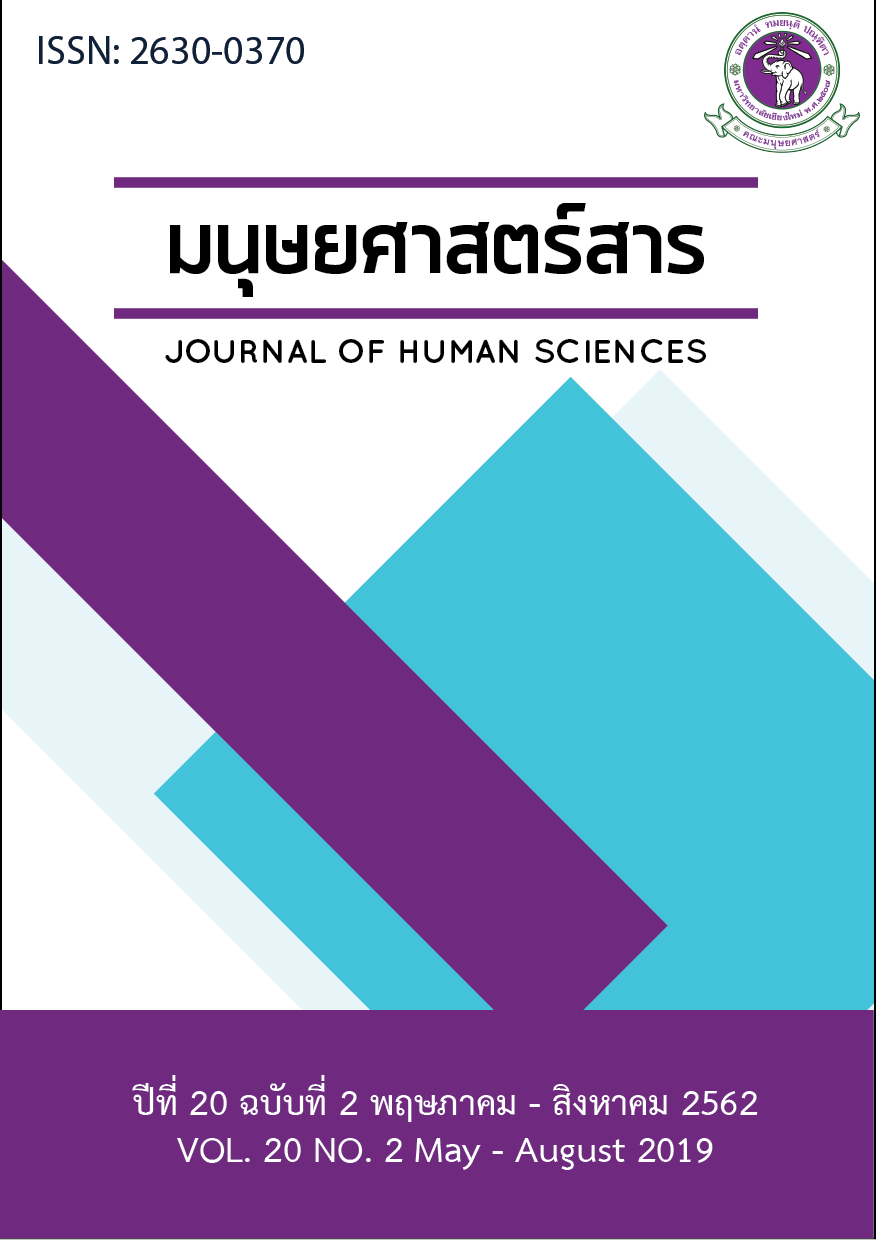Creating Added Value for Hmong Ethnic Identity in the Context of Creative Tourism Activities: A case study of Hmong Kiew Kan Village, Rim Khong Subdistrict, Chiang Khong District, Chiang Rai Province A case study of Hmong Kiew Kan Village, Rim Khong Subdistrict, Chiang Khong District, Chiang Rai Province
Main Article Content
Abstract
This qualitative research contained three objectives which were (1) to survey Hmong ethnic identity of Homg Kiew Kan Village, (2) to study the competency of Hmong ethnic identity which could increase the value of tourism through a creative tourism activity, and (3) to create a tourism pattern that increases the value of tourism through a creative tourism activity. The sample of this study included four sample groups which were a state unit, a private unit, local people, and tourists, a total of 73 people. The tools were a semi-structured interview and the data were summarized by thematic analysis. Based on the study, it was found that the Hmong ethnic identity of Homg Kiew Kan Village contained a diversity of cultures and could increase the value of tourism through a creative tourism activity. Consequently, the created tourism pattern of Homg Kiew Kan Village must be combined with tourism that consists of eight creative tourism activities which are Hmong agricultural lifestyle, Costume of the Mountain, Belief and Faith, Hmong’s New Year, Hmong Rhythm, Home on the Mountains, Wisdom of the Forest, and Color of their Clothes.
Article Details
References
Chuan, P. (2004). Elevation and Adaptation Local Wisdom in Current Situation. Sanpasathai, 2(3), 14-23.
Designated Areas for Sustainable Tourism Administration. (2013). CREATIVE TOURISM. Retrieved from https://www.dasta.or.th/creativetourism/th/article/155-notice3.html
Duangkamon, W. (2010). The Presentation of the Yuan ethnic identity in the context of tourism via local museum and riverside market: a case study of Yuan community, Tombon Tontan, Sao Hai district, Saraburi province. Bangkok: Chulalongkorn University.
Dulyapak, P. (2012). Ethnic Diversity and the Co-Existence of ASEAN Community. Bangkok: Thammasat University.
Foreign tourists, No.13 (T23). (Apr. 23, 2018). Interview.
Foreign tourists, No.7 (T17). (Apr. 19, 2018). Interview.
Guide Representative, No.1 (P09). (Jan. 16, 2018). Interview.
Guide Representative, No.3 (P11). (Jan. 16, 2018). Interview.
Lanjia Lodge Manager (P03). (Fed. 6, 2018). Interview.
Local people, No.1 (L01). (Mar. 19, 2018). Interview.
Local people, No.10 (L10). (Mar. 20, 2018). Interview.
Local people, No.12 (L12). (Mar. 20, 2018). Interview.
Local people, No.16 (L16). (Mar. 20, 2018). Interview.
Local people, No.17 (L17). (Mar. 20, 2018). Interview.
Local people, No.2 (L02). (Mar. 19, 2018). Interview.
Local people, No.20 (L20). (Mar. 20, 2018). Interview.
Local people, No.23 (L23). (Mar. 20, 2018). Interview.
Local people, No.3 (L03). (Mar. 19, 2018). Interview.
Local people, No.9 (L09). (Mar. 19, 2018). Interview.
Ministry of Social Development and Human Security. (2012). Meo. N.P.: The War Veterans Organization of Thailand.
Ngampit, S. (1999). Anthropology Research (4th ed.). Bangkok: Chulalongkorn University.
Office of Tourism Development, Department of Tourism, and Ministry of Tourism and Sports. (2007). Standards and Guidelines for Quality Assurance in Cultural Attractions (2 ed.). Bangkok: Chulalongkorn University.
Rim Khong Subdistrict Organization Representative, No.1 (G03). (Fed. 8, 2018). Interview.
Rim Khong Subdistrict Organization Representative, No.2 (G04). (Fed. 8, 2018). Interview.
Siraya, K. (2014). Creating Value from Upstream to Downstream. Chiang Mai: N.P.
Suddan, W. (2011). Creative Travel: Important Tools Leading to Sustainable Communities. Bangkok: Thammasat University.
Suthiwong, P. (2004). Southern wisdom. Nakhon Si Thammarat: Walailak University.
Thai tourists, No.1 (T01). (Mar. 14, 2018). Interview.
Thai tourists, No.6 (T06). (Mar. 9, 2018). Interview.
Thailand CBT Network Coordination Center. (2012). Community Based Tourism. Retrieved from https://thaicommunitybasedtourismnetwork.wordpress.com/cbt/
Thanarat, T. (2014). Creative tourism. Retrieved from https://www.suphan.dusit.ac.th/report/230757.pdf
Tipsuda, N. (1992). Language and Culture. Bangkok: Department of Religious Affairs.
Tourism Authority of Thailand Representative, Chiang Rai Office (G02). (Jan. 24, 2018). Interview.
Tourism Authority of Thailand. (2016). Thai tourism in 2017: Thailand as
a preferred destination. Retrieved from https://www.tatreviewmagazine.com/web/menu-read-tat/menu-2016/menu-42016/745-42016-th2560
Tourism Authority of Thailand. (2016). Tourism marketing strategy in 2017. Retrieved from https://zeekway.com/marketing-travel-2560-news/
Travel Agent Representative, No.1 (P04). (Fed. 3, 2018). Interview.
Travel Agent Representative, No.5 (P08). (Mar. 6, 2018). Interview.
Warach, M. (2013). Tourism Marketing for Long Stay Japanese Pensioner Tourists in Chiang Mai. Journal of Thai Hospitality and Tourism. 8(2), 48-61.
Waraluk, S. (2012). Communication Identity of Thai Private Higher Education (Master of Education, Nation University).

